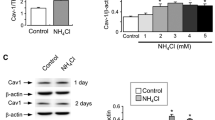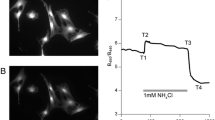Abstract
Rapid rise in ammonium concentration in the brain is the major pathogenic factor in hepatic encephalopathy that is manifested by state of confusion, forgetfulness and irritability, psychotic symptoms, delusions, lethargy, somnolence and, in the terminal stages, coma. Primary cultures of mouse astrocytes were used to investigate effects of chronic treatment (3 days) with ammonium chloride (ammonium) at 3 mM, this being a relevant concentration for hepatic encephalopathy condition, on metabotropic receptor agonist-induced increases in free cytosolic Ca2+ concentration [(Ca2+)i], measured with fura-2 based microfluorimetry and on store-operated Ca2+ entry (SOCE) activated following treatment with the SERCA inhibitor thapsigargin. The agonists used were the β-adrenergic agonist isoproterenol, the α2-adrenergic agonist dexmedetomidine, the InsP3 receptor (InsP3R) agonist adenophostin A and ryanodine receptor agonist 4-Chloro-m-cresol (4-CMC). Agonist-induced [Ca2+]i responses were significantly increased in astrocytes chronically exposed to ammonium. Similarly, the SOCE, meditated by the transient receptor potential channel 1 (TRPC1), was significantly augmented. The ammonium-induced increase in SOCE was a result of an up-regulation of mRNA and protein expression of TRPC1 in astrocytes. Increase in TRPC1 expression and in SOCE were both prevented by ouabain antagonist canrenone. Similar up-regulation of TRPC1 gene expression was found in the brain of adult mice subjected to intraperitoneal injection of urease for 3 days. In transgenic mice tagged with an astrocyte-specific or a neurone-specific markers and treated with intraperitoneal injections of urease for 3 days, the fluorescence-activated cell sorting of neurones and astrocytes demonstrated that TRPC1 mRNA expression was up-regulated in astrocytes, but not in neurones.






Similar content being viewed by others
References
Ede RJ, Williams RW (1986) Hepatic encephalopathy and cerebral edema. Semin Liver Dis 6:107–118
Link A, Kaplan BT, Bohm M (2012) 21-year-old woman with Reye’s syndrome after influenza. Dtsch Med Wochenschr 137:1853–1856
Felipo V (2013) Hepatic encephalopathy: effects of liver failure on brain function. Nat Rev Neurosci 14:851–858
van Caulaert C, Deviller C (1932) Ammoniémie expérimentale après ingestion de chlorure d’ammonium chez l’homme à l’état normal et pathologique. Compt Rend Soc Biol (Paris) 111:50–52
Xue Z, Li B, Gu L, Hu X, Li M, Butterworth RF, Peng L (2010) Increased Na, K-ATPase α2 isoform gene expression by ammonia in astrocytes and in brain in vivo. Neurochem Int 57:395–403
Butterworth RF, Norenberg MD, Felipo V, Ferenci P, Albrecht J, Blei AT, Members of the ICoEMoHE (2009) Experimental models of hepatic encephalopathy: ISHEN guidelines. Liver Int 29:783–788
Tian J, Cai T, Yuan Z, Wang H, Liu L, Haas M, Maksimova E, Huang XY, Xie ZJ (2006) Binding of Src to Na+/K+-ATPase forms a functional signaling complex. Mol Biol Cell 17:317–326
Verkhratsky A, Rodriguez JJ, Parpura V (2012) Calcium signalling in astroglia. Mol Cell Endocrinol 353:45–56
Kirischuk S, Parpura V, Verkhratsky A (2012) Sodium dynamics: another key to astroglial excitability? Trends Neurosci 35:497–506
Du T, Li B, Li H, Li M, Hertz L, Peng L (2010) Signaling pathways of isoproterenol-induced ERK1/2 phosphorylation in primary cultures of astrocytes are concentration-dependent. J Neurochem 115:1007–1023
Peng L, Yu AC, Fung KY, Prevot V, Hertz L (2003) α-adrenergic stimulation of ERK phosphorylation in astrocytes is α2-specific and may be mediated by transactivation. Brain Res 978:65–71
Virtanen R (1989) Pharmacological profiles of medetomidine and its antagonist, atipamezole. Acta Vet Scand Suppl 85:29–37
Parpura V, Grubisic V, Verkhratsky A (2011) Ca2+ sources for the exocytotic release of glutamate from astrocytes. Biochim Biophys Acta 1813:984–991
Putney JW Jr (1990) Capacitative calcium entry revisited. Cell Calcium 11:611–624
Parekh AB, Penner R (1997) Store depletion and calcium influx. Physiol Rev 77:901–930
Feske S, Gwack Y, Prakriya M, Srikanth S, Puppel SH, Tanasa B, Hogan PG, Lewis RS, Daly M, Rao A (2006) A mutation in Orai1 causes immune deficiency by abrogating CRAC channel function. Nature 441:179–185
Putney JW Jr (2007) Recent breakthroughs in the molecular mechanism of capacitative calcium entry (with thoughts on how we got here). Cell Calcium 42:103–110
Salido GM, Sage SO, Rosado JA (2009) TRPC channels and store-operated Ca2+ entry. Biochim Biophys Acta 1793:223–230
Verkhratsky A, Reyes RC, Parpura V (2014) TRP channels coordinate ion signalling in astroglia. Rev Physiol Biochem Pharmacol 166:1–22
Verkhratsky A, Parpura V (2014) Store-operated calcium entry in neuroglia. Neurosci Bull 30:125–133
Golovina VA (2005) Visualization of localized store-operated calcium entry in mouse astrocytes. Close proximity to the endoplasmic reticulum. J Physiol 564:737–749
Malarkey EB, Ni Y, Parpura V (2008) Ca2+ entry through TRPC1 channels contributes to intracellular Ca2+ dynamics and consequent glutamate release from rat astrocytes. Glia 56:821–835
Strubing C, Krapivinsky G, Krapivinsky L, Clapham DE (2003) Formation of novel TRPC channels by complex subunit interactions in embryonic brain. J Biol Chem 278:39014–39019
Reyes RC, Verkhratsky A, Parpura V (2013) TRPC1-mediated Ca2+ and Na+ signalling in astroglia: differential filtering of extracellular cations. Cell Calcium 54:120–125
Brusilow SW, Koehler RC, Traystman RJ, Cooper AJ (2010) Astrocyte glutamine synthetase: importance in hyperammonemic syndromes and potential target for therapy. Neurotherapeutics 7:452–470
Butterworth RF (2010) Altered glial-neuronal crosstalk: cornerstone in the pathogenesis of hepatic encephalopathy. Neurochem Int 57:383–388
Rose CF, Verkhratsky A, Parpura V (2013) Astrocyte glutamine synthetase: pivotal in health and disease. Biochem Soc Trans 41:1518–1524
Feng G, Mellor RH, Bernstein M, Keller-Peck C, Nguyen QT, Wallace M, Nerbonne JM, Lichtman JW, Sanes JR (2000) Imaging neuronal subsets in transgenic mice expressing multiple spectral variants of GFP. Neuron 28:41–51
Seki M, Nawa H, Morioka T, Fukuchi T, Oite T, Abe H, Takei N (2002) Establishment of a novel enzyme-linked immunosorbent assay for Thy-1; quantitative assessment of neuronal degeneration. Neurosci Lett 329:185–188
Diemer NH, Laursen H (1977) Glial cell reactions in rats with hyperammoniemia induced by urease or porto-caval anastomosis. Acta Neurol Scand 55:425–442
Hertz L, Schousboe A, Boechler N, Mukerji S, Fedoroff S (1978) Kinetic characteristics of the glutamate uptake into normal astrocytes in cultures. Neurochem Res 3:1–14
Hertz L, Peng L, Lai JC (1998) Functional studies in cultured astrocytes. Methods 16:293–310
Hertz L, Juurlink BHJ, Szuchet S (1985) Cell cultures. In: Lajtha A (ed) Handbook of Neurochemistry. Plenum Press, New York, pp 603–661
Meier E, Hertz L, Schousboe A (1991) Neurotransmitters as developmental signals. Neurochem Int 19:1–15
Hertz L, Bender AS, Woodbury DM, White HS (1989) Potassium-stimulated calcium uptake in astrocytes and its potent inhibition by nimodipine. J Neurosci Res 22:209–215
Wandosell F, Bovolenta P, Nieto-Sampedro M (1993) Differences between reactive astrocytes and cultured astrocytes treated with di-butyryl-cyclic AMP. J Neuropathol Exp Neurol 52:205–215
Lovatt D, Sonnewald U, Waagepetersen HS, Schousboe A, He W, Lin JH, Han X, Takano T, Wang S, Sim FJ, Goldman SA, Nedergaard M (2007) The transcriptome and metabolic gene signature of protoplasmic astrocytes in the adult murine cortex. J Neurosci 27:12255–12266
Fu H, Li B, Hertz L, Peng L (2012) Contributions in astrocytes of SMIT1/2 and HMIT to myo-inositol uptake at different concentrations and pH. Neurochem Int 61:187–194
Kong EK, Peng L, Chen Y, Yu AC, Hertz L (2002) Up-regulation of 5-HT2B receptor density and receptor-mediated glycogenolysis in mouse astrocytes by long-term fluoxetine administration. Neurochem Res 27:113–120
Ng LC, McCormack MD, Airey JA, Singer CA, Keller PS, Shen XM, Hume JR (2009) TRPC1 and STIM1 mediate capacitative Ca2+ entry in mouse pulmonary arterial smooth muscle cells. J Physiol 587:2429–2442
el-Marjou A, Delouvee A, Thiery JP, Radvanyi F (2000) Involvement of epidermal growth factor receptor in chemically induced mouse bladder tumour progression. Carcinogenesis 21:2211–2218
Lowry OH, Rosebrough NJ, Farr AL, Randall RJ (1951) Protein measurement with the Folin phenol reagent. J Biol Chem 193:265–275
Semplicini A, Serena L, Valle R, Ceolotto G, Felice M, Fontebasso A, Pessina AC (1995) Ouabain-inhibiting activity of aldosterone antagonists. Steroids 60:110–113
Rose C, Kresse W, Kettenmann H (2005) Acute insult of ammonia leads to calcium-dependent glutamate release from cultured astrocytes, an effect of pH. J Biol Chem 280:20937–20944
Batshaw ML, Hyman SL, Mellits ED, Thomas GH, DeMuro R, Coyle JT (1986) Behavioral and neurotransmitter changes in the urease-infused rat: a model of congenital hyperammonemia. Pediatr Res 20:1310–1315
Mobley HL, Hausinger RP (1989) Microbial ureases: significance, regulation, and molecular characterization. Microbiol Rev 53:85–108
O’Connor JE, Renau-Piqueras J, Grisolia S (1984) Effects of urease-induced hyperammonemia in mouse liver. Ultrastructural, stereologic and biochemical study. Virchows Arch B Cell Pathol Incl Mol Pathol 46:187–197
Hindfelt B (1975) On mechanisms in hyperammonemic coma—with particular reference to hepatic encephalopathy. Ann N Y Acad Sci 252:116–123
Hindfelt B (1975) The distribution of ammonia between extracellular and intracellular compartments of the rat brain. Clin Sci Mol Med 48:33–37
Burdakov D, Petersen OH, Verkhratsky A (2005) Intraluminal calcium as a primary regulator of endoplasmic reticulum function. Cell Calcium 38:303–310
Li B, Dong L, Fu H, Wang B, Hertz L, Peng L (2011) Effects of chronic treatment with fluoxetine on receptor-stimulated increase of [Ca2+]i in astrocytes mimic those of acute inhibition of TRPC1 channel activity. Cell Calcium 50:42–53
Parpura V, Verkhratsky A (2012) Homeostatic function of astrocytes: Ca2+ and Na+ signalling. Transl Neurosci 3:334–344
Wang F, Smith NA, Xu Q, Fujita T, Baba A, Matsuda T, Takano T, Bekar L, Nedergaard M (2012) Astrocytes modulate neural network activity by Ca2+-dependent uptake of extracellular K+. Sci Signal 5:ra26
Dai H, Song D, Xu J, Li B, Hertz L, Peng L (2013) Ammonia-induced Na, K-ATPase/ouabain-mediated EGF receptor transactivation, MAPK/ERK and PI3K/AKT signaling and ROS formation cause astrocyte swelling. Neurochem Int 63:610–625
Yan E, Li B, Gu L, Hertz L, Peng L (2013) Mechanisms for L-channel-mediated increase in [Ca2+]i and its reduction by anti-bipolar drugs in cultured astrocytes combined with its mRNA expression in freshly isolated cells support the importance of astrocytic L-channels. Cell Calcium 54:335–342
Acknowledgments
This study was supported by Grants No. 31171036 to L.P. and No. 31300883 to T.D. from the National Natural Science Foundation of China.
Author information
Authors and Affiliations
Corresponding author
Additional information
Chunguang Liang and Ting Du contributed equally to this article.
Electronic supplementary material
Below is the link to the electronic supplementary material.
Rights and permissions
About this article
Cite this article
Liang, C., Du, T., Zhou, J. et al. Ammonium Increases Ca2+ Signalling and Up-Regulates Expression of TRPC1 Gene in Astrocytes in Primary Cultures and in the In Vivo Brain. Neurochem Res 39, 2127–2135 (2014). https://doi.org/10.1007/s11064-014-1406-z
Received:
Revised:
Accepted:
Published:
Issue Date:
DOI: https://doi.org/10.1007/s11064-014-1406-z




